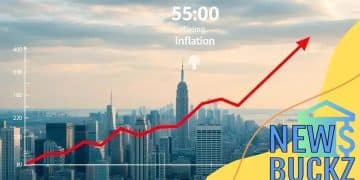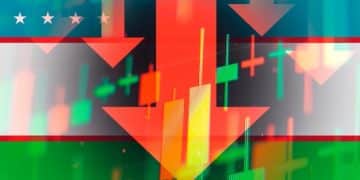Federal Reserve Holds Rates Steady: Experts Predict Potential Cut

Anúncios
The Federal Reserve maintained the federal funds rate at a target range of 5.25% to 5.5%, signaling a steady and cautious approach to monetary policy as they continue to evaluate incoming economic data.
Experts anticipate a potential interest rate cut in the next quarter, depending largely on how inflation trends evolve and whether economic conditions warrant additional easing.
The Federal Reserve’s recent decision to hold interest rates steady has been met with much anticipation and speculation.
Anúncios
The current rate, which sits at a target range of 5.25% to 5.5%, reflects a cautious approach by the central bank as it navigates a complex economic landscape.
Amidst this stability, experts are closely watching economic indicators, suggesting the possibility of an interest rate cut in the next quarter.
This potential shift could have significant implications for the economy, businesses, and consumers alike, making the current environment one of keen observation and strategic preparation.
Anúncios
Federal Reserve Holds Interest Rates Steady at 5.5%: Experts Predict Potential Cut in Next Quarter is a decision that warrants a closer look, as it balances current economic realities with future possibilities.
Federal Reserve’s Decision to Hold Steady
The Federal Reserve’s decision to maintain the federal funds rate at its current level is a significant move that reflects its assessment of the current economic conditions.
By keeping the rate unchanged, the Fed aims to balance the need to manage inflation with the desire to support economic growth.
This decision is influenced by various factors, including employment rates, inflation data, and global economic trends, all of which play a crucial role in shaping the Fed’s monetary policy.
Understanding the Fed’s Mandate
The Federal Reserve operates under a dual mandate set by Congress: to promote maximum employment and stable prices.
These two goals often require careful balancing, as actions taken to stimulate employment can sometimes lead to inflationary pressures, and vice versa.
The Fed uses various tools, including adjusting the federal funds rate, to achieve these objectives.
Factors Influencing the Decision
Several key factors likely contributed to the Federal Reserve’s decision to hold steady. These include:
- Inflation Trends: While inflation has cooled down from its peak, it remains above the Fed’s target of 2%. Holding rates steady allows the Fed to continue monitoring inflation without prematurely easing monetary policy.
- Employment Data: The labor market remains relatively strong, with low unemployment rates. This suggests that the economy can withstand the current interest rate environment without significant job losses.
- Global Economic Conditions: Uncertainty in the global economy, including geopolitical tensions and varying economic performances in other countries, also plays a role in the Fed’s decisions.
The decision to hold interest rates steady is a calculated move that takes into account a wide range of economic indicators.
The Fed’s commitment to its dual mandate requires a delicate balance between managing inflation and supporting economic growth.
By maintaining the current rate, the Fed is buying time to assess incoming data and make informed decisions about future monetary policy.
Expert Predictions and Analysis
While the Federal Reserve has chosen to hold steady for now, many experts are closely watching for signs of a potential rate cut in the near future.
These predictions are based on various economic forecasts and analysis of the Fed’s own statements.
Understanding these test programs is vital for businesses and consumers as they plan for the coming months.

Basis for Potential Rate Cut Predictions
Several factors underpin the экспертные прогнозы for a potential rate cut in the next quarter:
- Slowing Inflation: If inflation continues to decline towards the Fed’s 2% target, the pressure to maintain high interest rates will lessen.
- Economic Slowdown: A marked slowdown in economic growth could prompt the Fed to cut rates in order to stimulate economic activity.
- Global Economic Risks: Escalating global economic risks, such as a recession in major economies, could also lead to a rate cut as a preemptive measure.
Expert Opinions and Forecasts
Numerous economists and financial analysts have shared their insights on the likelihood of a rate cut. Some key opinions include:
- Optimistic Outlook: Some experts forecast a rate cut as early as the next quarter, citing the expectation that inflation will continue to fall.
- Cautious Approach: Others believe the Fed will remain cautious and wait for more definitive data before cutting rates.
- Data Dependency: Many agree that the Fed’s decision будет primarily based on incoming economic data, particularly inflation and employment reports.
The predictions for a potential rate cut vary among experts, reflecting the uncertainty inherent in economic forecasting.
However, the consensus appears to be that a rate cut is possible in the coming months, especially if inflation continues to decline and economic growth slows.
Impact on the US Economy
The Federal Reserve’s monetary policy decisions have a far-reaching impact on the US economy.
Holding interest rates steady at 5.5% and the potential for future rate cuts can affect everything from borrowing costs for businesses to consumer spending habits.
Understanding these impacts is crucial for businesses and individuals to make informed financial decisions.
Influence on Businesses
The decision to hold rates steady can have several impacts on businesses:
- Borrowing Costs: Stable interest rates provide predictability for businesses, making it easier to plan investments and expansions.
- Investment Decisions: Lower borrowing costs, resulting from potential rate cuts, можуть incentivizes businesses to invest in new projects and hire more workers.
- Profit Margins: Changes in interest rates can also affect businesses’ profit margins, particularly for those with significant debt.
Impact on Consumers
Consumers are also significantly affected by the Fed’s actions:
- Mortgage Rates: Lower interest rates can lead to lower mortgage rates, making homeownership more accessible.
- Savings Accounts: Высокие interest rates typically lead to higher returns on savings accounts, while lower rates offer smaller returns.
- Consumer Spending: Lower rates are intended to stimulate consumer spending by making borrowing cheaper.
The Fed’s monetary policy decisions have cascading effects throughout the economy, influencing business investments, consumer spending, and overall economic growth.
These decisions are carefully calibrated to achieve the Fed’s dual mandate of maximum employment and stable prices.

Historical Context and Precedents
Past Interest Rate Decisions
The Federal Reserve’s monetary policy decisions are shaped by a long history of economic events and policy responses. Some notable precedents include:
- The 2008 Financial Crisis: In response to the crisis, the Fed aggressively cut interest rates to near-zero levels to stimulate the economy.
- The Dot-Com Bubble: The Fed raised interest rates in the late 1990s to combat inflationary pressures caused by the rapid growth of the technology sector.
- The COVID-19 Pandemic: The Fed again lowered interest rates to near-zero and implemented quantitative easing measures to support the economy during the pandemic.
Lessons Learned
The historical precedents offer several key lessons:
- Swift Action: The Fed has often taken Swift action in response to economic crises to prevent or mitigate severe downturns.
- Data Dependence: Policy decisions are heavily reliant on incoming economic data, with the Fed adjusting course as needed.
- Unintended Consequences: Monetary policy decisions can have unintended consequences, such as asset bubbles or excessive inflation, which need to be carefully managed.
By studying historical precedents, policymakers and analysts can better understand the potential outcomes of current monetary policy decisions and make more informed predictions about the future.
Alternative Scenarios and Potential Risks
While experts anticipate a potential rate cut in the next quarter, it’s important to consider alternative scenarios and potential risks that could influence the Federal Reserve’s decisions.
Economic indicators such as inflation trends, labor market shifts, and global financial pressures all play a role in shaping the Fed’s approach.
The economic landscape is constantly evolving, and unforeseen events, like geopolitical tensions, supply chain disruptions, or sudden market volatility, can quickly alter the course of monetary policy, requiring a more flexible and responsive strategy.
Scenario 1: Persistent Inflation
If inflation proves to be more persistent than expected, the Fed may need to maintain current interest rates for longer or even raise them further. This scenario could lead to:
- Slower Economic Growth: Высокие interest rates can dampen economic activity and slow down growth.
- Potential Recession: Aggressive interest rate hikes could tip the economy into a recession.
- Market Volatility: Investor sentiment could sour, leading to increased market volatility.
Scenario 2: Unexpected Economic Shock
An unexpected economic shock, such as a geopolitical crisis or a natural disaster, could also alter the Fed’s plans. This could lead to:
- Emergency Rate Cut: The Fed might need to implement an emergency rate cut to support the economy.
- Quantitative Easing: Additional quantitative easing measures could be introduced to boost liquidity and stimulate lending.
- Increased Uncertainty: Uncertainty would increase, making it difficult for businesses and consumers to plan for the future.
Considering alternative scenarios and potential risks is essential for preparing for unexpected events and adapting to changing economic conditions.
The Federal Reserve’s monetary policy decisions are not made in a vacuum, and external factors can significantly influence its actions.
Strategies for Businesses and Consumers
Given the uncertainty surrounding future interest rate movements, businesses and consumers should consider implementing strategies to manage potential risks and take advantage of opportunities.
Proactive planning can help mitigate the negative impacts of economic volatility and position them for success.
This may include reassessing loan terms, locking in fixed interest rates, or adjusting investment portfolios to better align with evolving market conditions.
Strategies for Businesses
Businesses can adopt several strategies to navigate the current economic environment:
- Diversify Funding Sources: Explore different sources of funding to reduce dependence on traditional bank loans.
- Manage Debt Levels: Carefully manage debt levels to avoid being overleveraged in a rising interest rate environment.
- Invest in Efficiency: Increase operational efficiency to improve profitability and reduce costs.
Strategies for Consumers
Consumers can also take steps to protect their finances:
- Pay Down Debt: Focus on paying down high-interest debt to reduce financial strain.
- Build an Emergency Fund: Create an emergency fund to cover unexpected expenses.
- Review Investments: Review investment portfolios to ensure they are appropriately diversified and aligned with their risk tolerance.
By implementing proactive strategies, businesses and consumers can better manage the risks associated with economic uncertainty and position themselves for long-term financial success.
These strategies require careful planning and a thorough understanding of the economic landscape.
| Key Point | Brief Description |
|---|---|
| 📊 Fed’s Decision | The Fed held interest rates steady at 5.5%, balancing inflation and growth. |
| 🔮 Expert Predictions | Analysts foresee a potential rate cut next quarter if inflation declines. |
| 💼 Business Impact | Stable rates aid planning; potential cuts encourage investment and hiring. |
| 🏡 Consumer Impact | Lower rates can reduce mortgage costs and stimulate consumer spending. |
Frequently Asked Questions
▼
The current federal funds rate, as set by the Federal Reserve, remains at a target range of 5.25% to 5.5%. This rate has been held steady in recent decisions as the Fed evaluates ongoing economic data.
▼
The Federal Reserve held interest rates steady to balance managing inflation with supporting economic growth. This approach allows the Fed to monitor economic indicators without prematurely adjusting monetary policy.
▼
Experts predict a potential interest rate cut in the next quarter, contingent on declining inflation and a possible economic slowdown. The Fed’s decision will primarily depend on incoming economic data.
▼
Interest rate decisions impact borrowing costs for businesses, influencing investment decisions and profit margins. Stable or lower rates can encourage business investment and expansion opportunities.
▼
Interest rate decisions can affect mortgage rates, savings account returns, and consumer spending. Lower rates can make borrowing cheaper, stimulating spending, and influencing homeownership affordability.
In summary, the Federal Reserve’s decision to hold interest rates steady reflects a cautious approach to balancing economic growth and inflation management.
While experts predict a potential rate cut in the next quarter, this outcome hinges on incoming economic data and the evolving economic landscape.
Businesses and consumers should remain vigilant and implement proactive strategies to navigate potential risks and opportunities.





